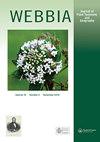Evaluating the species distribution patterns of the genus Saurauia Willd. in the Philippines using geospatial analysis
Q3 Agricultural and Biological Sciences
引用次数: 0
Abstract
Understanding the species distribution patterns of endemic and threatened species is very useful for conservation planning and actions. However, research on the distribution of many important and often overlooked species in the country, such as the Saurauia, is extremely limited. This paper provided an overview of the distribution patterns of Saurauia species across the Philippine archipelago based solely on the existing digital checklist of vascular plants. Specifically, the study produced distribution maps of the 56 endemic Saurauia species and determined their climatic distribution ranges. The methods involved geospatial and geoprocessing analysis in a geographic information system (GIS) environment. The findings showed that 29 Saurauia species are currently distributed in a single province, whereas seven (7) species have only been recorded in a certain region. Furthermore, 35 species was found to have a single type of climate. The Saurauia species identified in this paper that have only a single provincial or regional distribution record and are restricted to a single type of climate are recommended for conservation because they are mostly likely to be affected by environmental and climatic changes. Finally, the information and data derived in this paper could serve as a baseline for assessing conservation status, habitat modelling studies, species-level conservation planning, and understanding climate change impacts.野生蜥蜴属物种分布格局的评价。在菲律宾使用地理空间分析
了解特有种和濒危物种的分布格局对保护规划和保护行动具有重要意义。然而,对该国许多重要而经常被忽视的物种的分布的研究,如蜥蜴,是非常有限的。本文仅基于现有的维管植物数字清单,概述了菲律宾群岛蜥蜴属物种的分布模式。具体来说,该研究绘制了56种特有蜥蜴物种的分布图,并确定了它们的气候分布范围。方法涉及地理信息系统(GIS)环境下的地理空间和地理处理分析。结果表明,目前在一个省分布有29种蜥蜴,而在某一地区只记录到7种。此外,还发现35个物种只有一种气候类型。本文所鉴定的蜥蜴属物种仅在一个省或地区有分布记录,并且仅限于一种气候类型,因为它们最容易受到环境和气候变化的影响,因此建议予以保护。最后,本文获得的信息和数据可作为评估保护状况、栖息地模型研究、物种层面保护规划和了解气候变化影响的基线。
本文章由计算机程序翻译,如有差异,请以英文原文为准。
求助全文
约1分钟内获得全文
求助全文

 求助内容:
求助内容: 应助结果提醒方式:
应助结果提醒方式:


